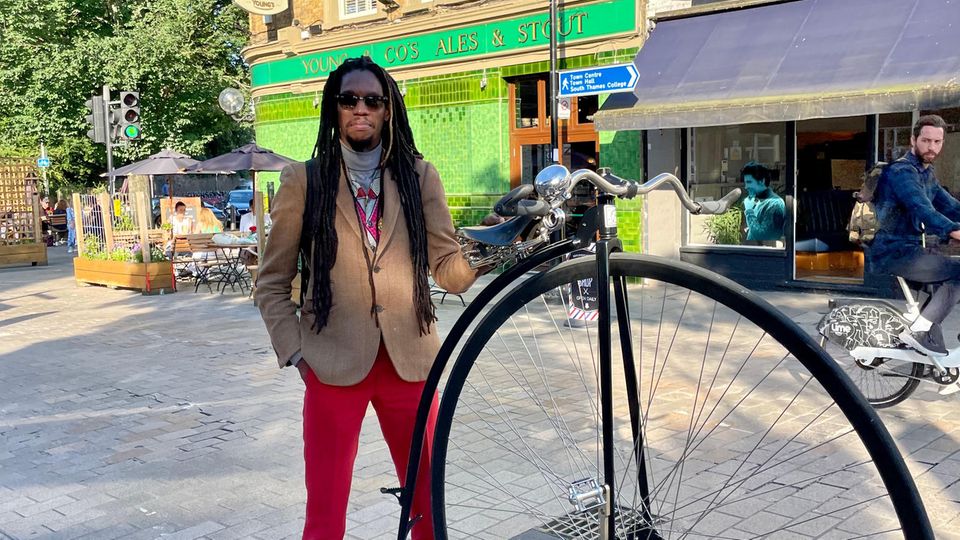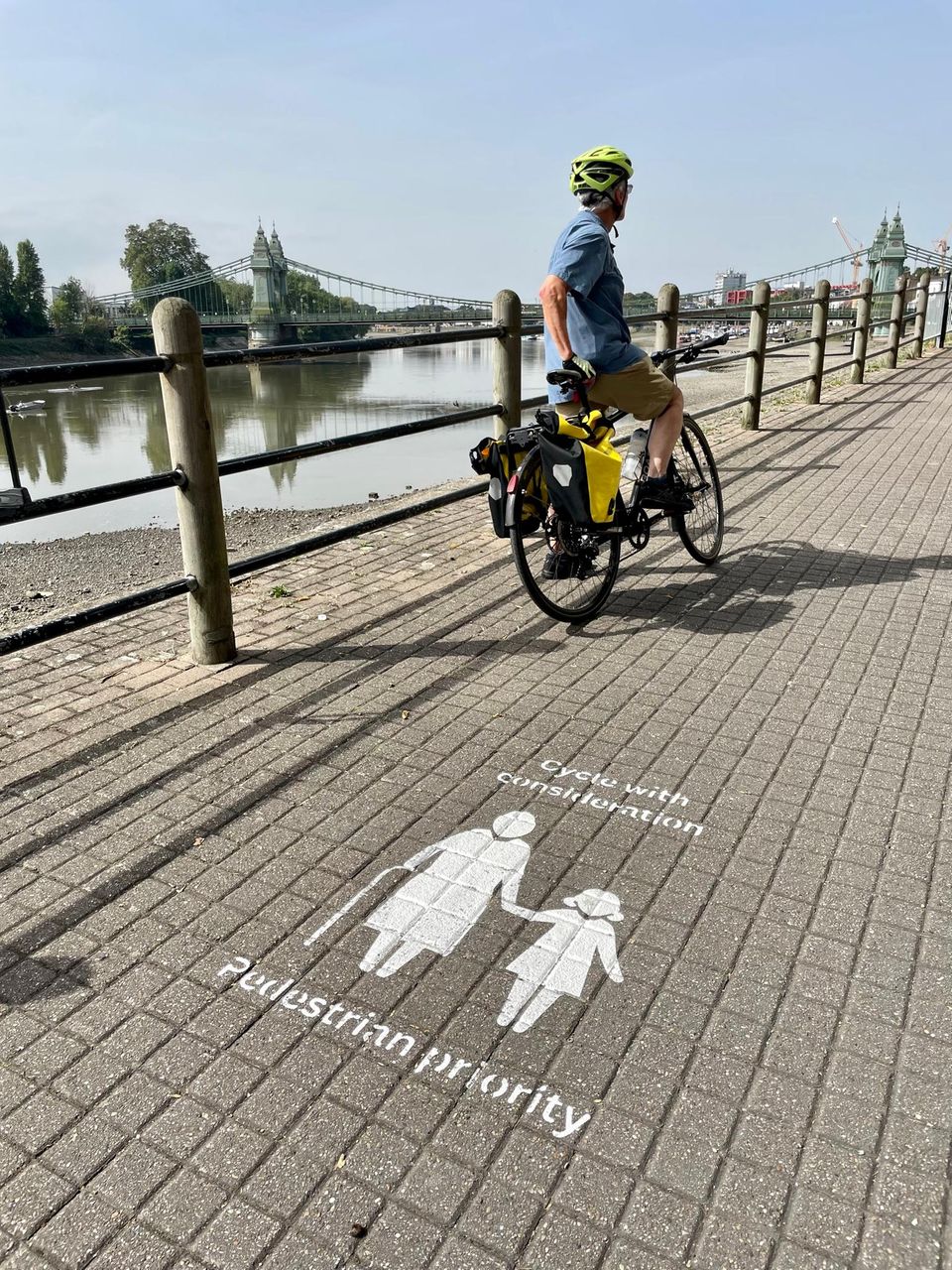London has recently become pleasant and safe to explore by bike – at least in parts. What you should consider when cycling through the city.
The good news first: With the introduction of the first low emission zone five years ago and the new maximum speed of 30 km/h in many inner city areas, it’s not just the air that has become much better in London. Three London mayors – Ken Livingstone, Sadiq Khan and even Boris Johnson in his Liberal incarnation – have done much over the last two decades to ensure that cycling in the city is no longer a survival exercise. However, tourists should consider a few important tips before hopping on their own or a rental bike in London.
Left-hand traffic
“Look right” – “Look to the right!” is always written in large white letters on the footpaths where there are particularly many tourists. The little reminder for visitors that traffic is coming from the other direction is even more important for cyclists than for pedestrians. If you want to get used to driving on the left in a safe environment, you can do so in the city’s large parks. Hyde Park in the center, Battersea Park on the south side of the Thames, Richmond Park in the southwest and the Olympic Park in the Lea Valley in the northeast are particularly recommended. Attention: Cyclists are not allowed in every city park – admission is at the discretion of the city district administration.
“Look right” is written on the road in front of St. Pancras Eurostar station as a reminder of left-hand traffic in England
© Dagmar Seeland
potholes
Traffic roundabout
The Brit likes to drive in circles a lot. Traffic roundabouts come in all sizes and complexities, but the craziest one of all, the “Magic Roundabout”, is in the town of Swindon in Wiltshire. The roundabout there with six mini-roundabouts is a sight.
Traffic circles have been proven to reduce serious accidents, but they are not always easy to navigate. Fortunately, many large traffic circles in London now have separate cycle paths, and some even have their own traffic lights. Where this is not the case, the following rules also apply to cyclists: Vehicles coming from the right always have the right of way. Treat roads branching off the roundabout like the face of an analog clock; If your departure is before “twelve o’clock”, then you drive in the left lane; if it is after twelve o’clock, the middle lane applies or, in the case of three-lane roundabouts, the right lane. Overtaking on roundabouts is prohibited under British law, but that doesn’t mean everyone follows this traffic rule. It is therefore advisable to constantly look over your shoulder when maneuvering the gyro. If all this is too much for you, cyclists can stick to the outside lane, but clear hand signals are particularly important so that other road users know where you are leaving the roundabout.
A word of advice: avoid the roundabout at Hyde Park Corner if you value your life. A very special place in traffic offender hell goes to the planner (and it was certainly a man) who designed this six-lane death spiral.
Follow the “Cycle Routes”
White letter combinations such as “C14” or “Q25” on the asphalt are not a secret code, but rather signal that you are cycling on one of the “Cycleways” of the official London cycle path network. Previously, a distinction was made between “Cycle Superhighways” and “Quietways”. “Highways” and the quiet paths through quiet residential areas. For a few years now, London’s central transport authority has been trying to combine the routes into a safe, uniformly marked network. An interactive map of all routes can be found here on the Transport for London website. Some, especially the C3 cycle path along the Thames, are completely separated from other traffic in sections and in some cases even have their own traffic lights and mini-crossings for cyclists. Tip: The C3 is well traveled, especially in the financial district. The pace is sporty and things can get tight here and there. Above all, avoid peak times in the morning and at the end of the day.
Bike-friendly neighborhoods
Not everyone in London likes cyclists. This is evidenced by many a beautiful cycle path that suddenly disappears into thin air in the thick of traffic because you have crossed an invisible city boundary. Expanding the bicycle network is a constant tug of war between Mayor Sadiq Khan’s central transport authority and city councilors. With a few exceptions, Labor-governed boroughs are more bike-friendly – prime examples are Walthamstow, Camden and Enfield. The Tory-governed “royal” districts of Westminster and Kensington & Chelsea in the center and west of the city, on the other hand, are too refined for two-wheelers and only reluctantly comply with the mayor’s orders. The city council of Hammersmith & Fulham behaves in a similar way. She even went so far as to keep the Hammersmith Bridge, which had been closed to motorized traffic for years due to its state of disrepair, also closed to bicycles.
A little etiquette lesson
The British are known to be a polite people – the Brexit drama was a blip. Good manners also prevail on streets and cycle paths, especially where they are shared with pedestrians.
Martin Nelson, opera singer and London bicycle pioneer (he designed the first bicycle route in the city center in 1977) recommends “grand gestures” in traffic. “Exaggerate a little when you signal that you want to turn right, this will make you more visible to drivers.” For example, he gives priority to passers-by waiting at a zebra crossing with a sweeping half bow as they approach. “Politeness improves our reputation as cyclists.” On paths shared with pedestrians, cyclists should keep a civilized pace and get off when things get tight, “and not just when you’re already cycling next to people.” Excessive ringing is also not well received by English people. “Once is enough.”
General tips: bicycle helmet and bicycle rental
Wearing bicycle helmets is recommended, but not mandatory. The same applies to reflective clothing in bad weather and at night. If you’re planning trips to the outskirts of London, you can take your bike with you on suburban trains for free – and, for that matter, on the subways where they run on the surface. Bicycles are not allowed on trains during rush hour, i.e. between 7 a.m. and 10 a.m. in the morning and between 4 p.m. and 7 p.m. in the evening. The new Elizabeth Line is the only tube line to allow bicycles on the entire route, and the regular Thames Clipper boat service also carries bicycles at no extra charge. However, the exceptional times already mentioned also apply here.
Addresses:
Santander Cycle Hire, the official bike rental company of the City of London, has 800 bike stations throughout the city center and now also a few e-bikes. The app shows all stations at a glance, and which ones have how many bicycles or free parking spaces.
Lime works like in Germany via the app.
Human Forest is a responsible London e-bike rental company. “Wild parking” costs money. Anyone who parks at one of the stations will receive free bicycle minutes. Download the app.
The boat ferry Thames Clipper operates between Banking Riverside Pier to the east and Putney Pier to the west and transports bicycles free of charge. Up to 14 wheels per boat.
Beautiful bike routeswhich largely avoid busy roads, can be found here:
Bicycle shops and workshops do you think …? Find here
stern correspondent Dagmar Seeland tests various cycle paths in London. Read about your tour of Little Holland in England here.




